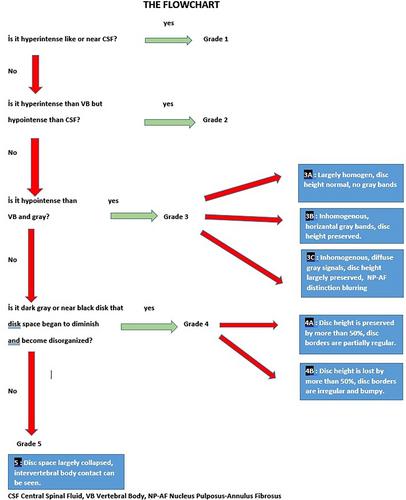Tracing the disc: The novel qualitative morphometric MRI based disc degeneration classification system
Abstract
Background
This study aimed to develop a classification system for lumbar disc degeneration using routine magnetic resonance images (MRIs) that is easily applicable and unaffected by existing classifications' limitations, and to compare its reliability, reproducibility, and discriminative power to the widely used Pfirrmann classification.
Methods
Five features were graded. This new classification system has eight grades, with at least one of these five features altering each grade. The T2-weighted sagittal images were acquired using a rapid spin-echo sequence with a repetition time of 2680 to 4900 milliseconds, an echo time of 100 to 109 milliseconds, and an echo train length of 17. Slice thick was 4 mm and the display field of view was 32 × 32 cm. The new classification system used five features: signal intensity, disc height, disc boundary regularity, and nucleus annulus separation. Increased signal intensity, decreased height, decreased regularity, and decreased nucleus-annulus separation indicated degeneration. Four raters classified 400 discs from 80 patients using the Pfirrmann and Novel systems. Statistical analyses were conducted to investigate reliability and correlation.
Results
The overall ICC and kappa values were found to be higher in the novel classification. (0.988 indicating excellent agreement for ICC and 0.76/0.94 indicating good–very good agreement for kappa). The Kendall tau c value, which shows the correlation between the two classifications and indicates the validity of the new classification, was 0.872, which is very strong. Through the use of cross-tabulations, the discriminatory power of the two newly added classification criteria was determined.
Conclusions
This study demonstrates the intra-rater and inter-rater reliability of an easy-to-use, discriminative novel morphometric MRI based classification system for lumbar disc degeneration. The differentiation of grades based on five distinct criteria may generate novel hypotheses regarding treatment selection and response monitoring, as well as new insights into the study of disc degeneration.


 求助内容:
求助内容: 应助结果提醒方式:
应助结果提醒方式:


